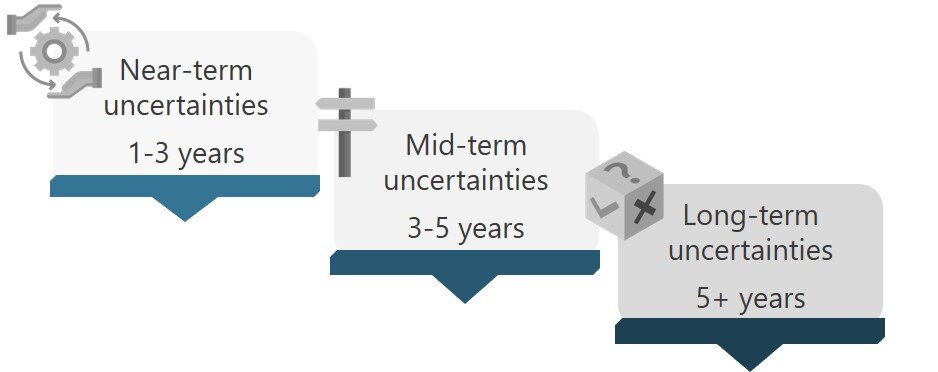Managing Uncertainty – Choosing the Tools to Fit the Timeframe
David and Goliath. Netflix and Blockbuster. Lipitor vs. competitor statins. Across industries and age-old stories, there is no shortage of examples in which a new, confident but underestimated competitor is – in the end – victorious. When we think about these examples in pharma, how do we understand the critical inflection points and moments where leadership could have planned differently to avoid these pitfalls? Does a lack of focus on uncertainty within our processes significantly increase risk?
Let us first consider the example of Blockbuster vs. Netflix. In the year 2000, at Blockbuster’s prime, Netflix co-founders approached the then market leader with a merger proposal: Blockbuster would pay $50m for Netflix and Netflix would take on responsibility for all future online and streaming services. Apparently the two co-founders were laughed out of the room. That same year, Netflix launched its own online streaming platform. Blockbuster proceeded to make reactive changes to remain competitive by eliminating previously lucrative late fees and evaluating an online streaming capability, but it was too little, too late. Blockbuster filed for bankruptcy in 2010 and closed all but one of its stores by 2013. Today, Netflix is valued at $203bn.
In the context of Blockbuster’s story, there is a spectrum of different types of uncertainties that could have been better managed to ensure preparedness for disruptive events. When discussing uncertainties and risk, timing matters. What does the timeline associated with an uncertainty indicate about its likelihood and potential impact on our business? And what does this mean when we explore how to best manage each uncertainty type, whether it is near-, mid- or long-term?

Short-term Uncertainties
Near-term uncertainties generally encompass events occurring in the next 1-3 years. Given the timeframe, these are usually occurrences we can predict with a greater degree of accuracy and are thus highly probable, with a moderate but potentially significant impact on our business. In the case of the Blockbuster example, these types of uncertainties would relate to the day-to-day operations; what if Blockbuster had proactively planned for uncertainties around changing customer needs, and the shift in market dynamics that would play out in case a new competitor addressed these needs? Would Blockbuster have put more thought into growing customer frustration with late fees and an increasing desire for product convenience?
In pharma, near-term uncertainties include risk types that generally fall into one of two categories. Event-based risks are either single outcome (e.g. clinical trial outcomes) or multi-factorial (e.g. competitor launch timings and product profile), whereas environment-based uncertainties are those pertaining to specific market dynamics. Near-term scenario planning exercises enable us to craft proactive and reactive response strategies, tactics and message concepts for each eventuality. These short-term scenario planning exercises can be done in the context of both evolving competitive landscapes or changing attitudes of key stakeholders through Competitor or Stakeholder Simulation Workshops, enabling team alignment on base case and contingency plans.
Mid-term Uncertainties
Mid-term uncertainties are those 3-5 years in the future, and although these can be lower in probability than near-term uncertainties, they may have a higher impact on our business should they happen. These uncertainties and associated risks are not normally addressed by specific tactics, objection handlers, or messages within a typical brand plan, nor are they typically considered when creating a future-looking ‘vision’ or long-term plan, or during scenario planning. For Blockbuster, did they fail to see that the technology was already evolving and customers were beginning to become more reliant on electronic devices? The signs were already there.
A few years ago, would analysts have expected Gilead’s growing HCV franchise to stall so abruptly? As Gilead responded to near-term competitive events, and drove a then winning strategy of providing premium-priced treatment options (Sovaldi, Harvoni and Epclusa), did it expect AbbVie to launch Mavyret at such a deep discount and drive access as a prime differentiator? Did Gilead effectively consider mid-term uncertainties in its franchise strategy, or did it focus on driving a short-term growth strategy and assume that competitors such as AbbVie would price at parity?
For any business, managing mid-term uncertainties in addition to planning for near-term risks is critical. By undergoing an uncertainty prioritisation process, teams can typically strengthen their brand/franchise situation analysis and develop a set of market-shaping and monitoring activities that support planning amid multiple unknowns.
Long-term Uncertainties
Finally, long-term uncertainties are those that impact a business’s future-looking ‘vision’. Where will the business be in 5-10 years, what are the potential disruptors from ‘left-field’ we need to be ready for, and what signals should we be looking for to indicate that long-terms risks might become more likely? Given how far out these uncertainties are, we are less likely to accurately predict them, and thus the potential events are usually lower probability. Although the importance of planning for these events is often underestimated, this exercise is a critical step for long-term planning; should one of these uncertainties play out, they are likely to change the way in which we do business/deliver treatment to our patients in a profound way.
Being prepared for this kind of uncertainty enables companies to objectively assess risk to their business model stemming from relatively dramatic changes to the landscape and adapt accordingly. If Blockbuster had done more planning around the (then) potential move to online and identified this potential shift as a priority risk, surely it would have snapped up Netflix for $50m when given the chance! It is not that they missed the boat on going digital – we saw Blockbuster move into that space later in the 2000s. It is simply that it did not take it seriously in terms of the ‘risk’ to its future business.
What about long-term uncertainties in pharma? How could the entry of a revolutionary curative therapy or new drug delivery methods affect our franchise? What about potential shifts in decision-making from general practitioners to pharmacists as the role of the pharmacy as we know it begins to change? Planning for these longer-term uncertainties requires exercises such as long-term scenario planning, franchise strategy development and early LCM planning to ensure long-term plans are robust.
The future is a Pandora’s box of potential disruptors and thus planning and preparing for these events is in the DNA of all successful brands/companies. Because despite all the uncertainty our businesses may face in the future, one thing is for sure: some form of new disruption is certain.
To receive further material on these different types of uncertainty, including additional insight on managing these uncertainties within pharma, provide your details below. In the meantime, watch this space for our next post on managing uncertainty where we take a closer look at how to handle mid-term uncertainties and associated risks when failing to do so.

